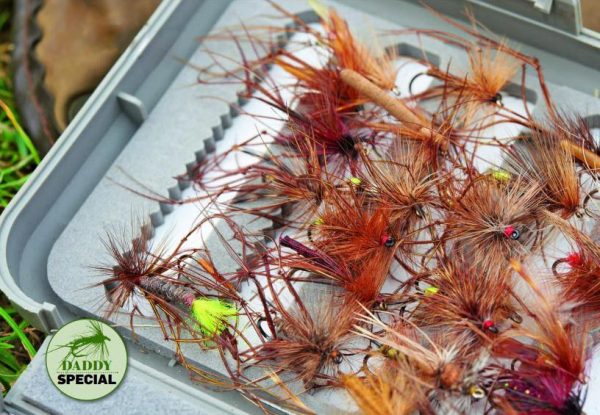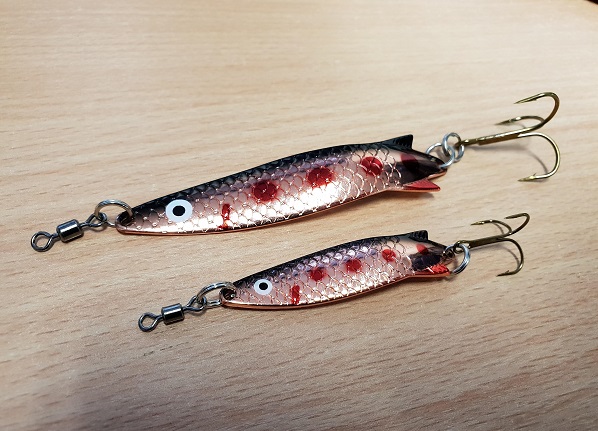From now onwards, August often sees an explosion of daddy longlegs on surrounding grassland and over our trout waters. These large gangly-legged insects provide a real mouthful for hungry trout and are easily imitated by the angler. Get it right and you are sure to experience some memorable fishing.
Perfect conditions would be an overcast warm day, with overnight rain and a moderate 6 – 12mph wind, perfect conditions for the insects to hatch and for the trout to feed. In this article, we will be looking at the 4 best ways to fish daddies.

Always Have A Selection Of Daddies To Cover All Options
1 WHEN THERE’S ACTIVITY ON THE SURFACE
We like to fish a two-fly cast, with a Foam Daddy on the point. This is an almost perfect representation of the real fly and it sits high on top of the water. On the dropper, we recommend fishing an Amber or Orange Hopper (not greased up at all so it sinks slowly and sits just a foot or two under the surface – held up by the Foam Daddy). Our recommended set-up details are a 12-foot leader of 8lb line – seven feet to the top dropper then five feet to the point fly. Rises to daddies are distinctive; often splashy compared to head-and-tail rise forms when fish are taking buzzers trying to emerge through the water’s surface. Trout also seem to come back for the same daddy – such is the draw of such a large food source. In perfect conditions fish will take a Daddy sitting high and proud on the surface but, more often, they try to sink the fly with a slash of their tail. It’s for this reason that you can get a high number of foul-hooked fish. Then, once the fly is subsurface, they can confidently feed and take the pattern because the fly is not going to escape. The Amber or Orange Hopper is slightly smaller and accurately imitates some of the variations of the insect and because the Hopper sits subsurface it’s usually the pattern that takes the most fish. The trout are pulled up to the silhouette of the larger fly and take the smaller one suspended below. Both patterns are essential in order to increase your catch rate – Try fishing two Amber Hoppers subsurface (because this is the fly that takes most fish) but once the Daddy pattern is off the leader the takes literally dry up. They fish more effectively as a ‘tag team’.

A Pristine Rainbow Caught On A Daddy
2 WHAT TO DO WHEN SURFACE ACTIVITY STOPS
Once the surface activity has stopped, try fishing a team of three Daddies and Hoppers on a sink tip. These patterns quickly cut through the surface film, but sink slowly because they’re held up by the air that’s trapped in their hackles and legs. If fished static they can reach depths of eight to 12 feet, depending on the speed of retrieve and leader material. Just because the pattern is no longer effective on the surface, it doesn’t mean it won’t work when fished deeper. The fish are, to a certain extent at this time of year, conditioned to feed on daddies. They expect them in the water and are used to seeing them. If you get a sudden downpour or high winds, daddies can be sunk and are often naturally taken deeper than most anglers think. When fishing the Sunk Daddy a three-fly leader set up with 16 feet of 8lb fluorocarbon line with six feet to the top dropper, four feet to middle dropper (a size 12), then six feet to the point. The midge-tip line is perfect for this style of fishing. With a Foam Daddy or Popper Hopper on the point and Hoppers on the droppers, you can make a cast and literally fish the flies on the drop. The foam pattern will hold the flies up in the water, with the droppers just subsurface. All you ever need to do is keep in touch and let the trout find your flies. Takes are often very aggressive and hard to miss. Your patterns are behaving just like a sunken natural dropping slowly through the surface layers. .
Daddy Hog
from £1.30Mini Foam Daddy
from £1.30Daddy Longlegs
from £1.30Pearly Daddy
from £1.30Olive Damsel
from £1.30CDC Daddy
from £1.30
3 ON VERY WINDY DAYS
Now you can strip Daddies through the surface. We recommend using a Popper Hopper or Booby Hopper on the top dropper (these patterns create more disturbance than a Muddler so in our opinion are favourable) followed by two Daddies, both five feet apart on the leader set-up. Try to cover as much water as possible and literally strip the flies back medium pace causing a disturbance. Try stopping halfway back for 10-15 seconds, literally just waiting to see if any following fish will take. Often it’s when you start to strip again that the takes occur. The fish might follow and decide not to take, even when the flies are left to slowly drop through the surface layer. Then, as you start to pull again, it’s a natural reaction because they think the food is going to escape – so they take. Without the pause, you can’t get this effect. A recommended setup consists of a leader of 8lb fluorocarbon with six feet to the top dropper (a Booby Hopper or Popper Hopper), then a middle dropper and then a point fly.

A Goldhead Daddy Is Ideal For Stalking Tactics On Smaller Stillwaters
4 DADDIES FOR STALKING
Goldhead Daddies are particularly effective on smaller stillwaters rather than reservoirs. We’re not convinced that they’re actually taken for a cranefly imitation, we believe it’s more that the pattern is fished at the correct depth – deep, because the gold bead pulls the fly down – and that the fly has the right attributes to stimulate fish into feeding. I find the Goldhead Daddy is an ideal pattern for stalking. It gets down fast to the level of the cruising fish, it’s visible because of its size and it’s usually tied in a natural brown non-scary colour – an ideal pattern to use when lure patterns are only producing follows. Our most effective daddy longlegs pattern on small stillwaters is a goldhead version with knotted rubber legs because it has so much movement. We accept that it’s not really a traditional Daddy and could even be termed a lure, but we do consider it a must have fly. Our recommended set up is just a simple 12-foot leader of 8-10lb fluorocarbon with a Goldhead Daddy – occasionally we will substitute a gold bead for a tungsten bead because this allows us to get deeper, faster. We find that a sharp erratic retrieve made up of short three to six-inch pulls work best because it gets the fly pulsating underwater, especially the legs, and really induces the take.













